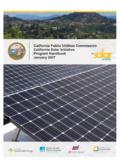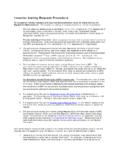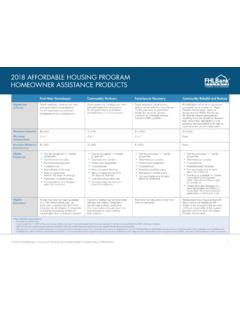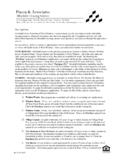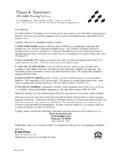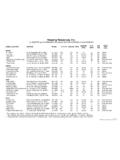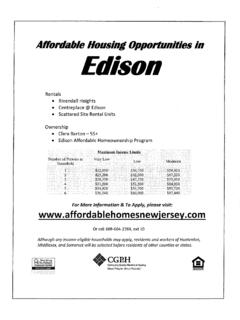Transcription of California Public Utilities Commission Multifamily ...
1 California Public Utilities Commission Multifamily affordable Solar housing Program HandbookFirst Edition The California Public Utilities Commission (CPUC) prohibits discrimination in employment, its regulatory programs , and activities on the basis of race, national origin, color, creed, religion, sex, age, disability, veteran status, sexual orientation, gender identity, or associational preference. The CPUC also affirms its commitment to providing equal opportunities and equal access to CPUC regulated facilities and programs . For additional information or to file a complaint, contact the State Personnel Board, Office of Civil Rights, Discrimination Complaint Monitoring and Analysis, Kristen Trimarche (916) 653-1621. Table of Contents i Multifamily affordable Solar housing Program Handbook First Edition 1. Introduction: California Solar Initiative Program .. 4 Program Overview .. 4 Getting Started with Solar.
2 9 MASH Handbook Structure .. 9 MASH Program Administrator Contact Information and Other Useful Resources . 10 Program Section .. 13 2. Program Eligibility Criteria and Requirements .. 14 MASH Program Participants .. 14 Generation System Equipment Eligibility .. 19 Energy-Efficiency Requirements .. 22 Energy Saving Assistance (ESA) Program Requirements .. 23 Job Training Requirements .. 23 Affidavit Ensuring 50% Tenant Economic Benefit .. 25 Warranty Requirements .. 26 Performance and Permanency Requirements .. 26 Interconnection to the Electric Utility Distribution System .. 27 Metering Requirements .. 28 Inspection Requirements .. 28 Measurement and Evaluation Requirements .. 29 MASH Program Database Requirements .. 29 Additional Requirements and Terms .. 30 3. Multifamily affordable Solar housing Incentive Structure .. 31 Expected Performance Based Buydown (EPBB) Incentives .. 31 Incentive Limitations.
3 33 Other Incentives or Rebates ..35 Right to Audit Final Project Costs and Affidavits ..35 Site and Host Customer Limitations ..36 Table of Contents ii Multifamily affordable Solar housing Program Handbook First Edition Limitations on Installed Cost ..36 4. Application Process for MASH Projects .. 38 Application Process for MASH Projects .. 38 Application Forms and Documentation .. 44 Changes to 52 Incentive Payment Process .. 54 System Changes Affecting Incentive Amount .. 55 MASH Project Review .. 56 Notifications, Sanctions and Dispute Resolution .. 59 Expended Budget Guidelines .. 61 Technical Section .. 64 5. Metering Requirements .. 65 EPBB Metering Requirements .. 65 Minimum Metering Equipment Requirements .. 66 Minimum Communication Requirements .. 67 Minimum Performance Monitoring & Reporting Capability Requirements .. 67 Advanced Metering Infrastructure (AMI) Coordination.
4 68 MASH Program Administrator Liability .. 68 6. Equipment Certification, Rating Criteria & Design Factor Calculations .. 69 Equipment Certifications and Rating Criteria .. 69 Design Factor Calculation: Expected Performance Based Buydown (EPBB) Incentive .. 69 7. Field Verification .. 72 8. Surface Orientation Factors for California Locations .. 73 9. Acronyms .. 74 Appendices .. 77 Appendix A: Definitions .. 78 Table of Contents iii Multifamily affordable Solar housing Program Handbook First Edition Appendix B: Additional Requirements and Terms .. 90 Appendix C: Inverter Integral 5% Meter Performance Specification and Test Requirements .. 94 Appendix D: Cover Sheet for Public Utilities Code Section 2852 Documentation .. 130 Appendix E: Affidavit Ensuring 50% Tenant Economic Benefit .. 133 Appendix F: Job Training Affidavit .. 135 Appendix G: ESA Information Notice for Tenants .. 144 4 Multifamily affordable Solar housing Program Handbook First Edition 1.
5 Introduction: California Solar Initiative Program Program Overview The Multifamily affordable Solar housing (MASH) Program is overseen by the California Public Utilities Commission (CPUC or Commission ) and provides incentives to qualifying affordable housing within the service territories of Pacific Gas & Electric Company (PG&E), Southern California Edison Company (SCE), and San Diego Gas & Electric (SDG&E). In Decision (D.) 06-01-024, the CPUC collaborated with the California Energy Commission (CEC) to establish the California Solar Initiative (CSI) and the New Solar Homes Program (NSHP) to fund rebates for installation of qualifying solar energy systems for customers of PG&E, SCE), and SDG&E1. In that decision, the Commission committed ratepayer funds of $ billion over a 10-year period for solar incentives and required that 10% of the funds be used for projects for low-income residential customers and affordable housing projects.
6 In March 2006, the Commission opened a new proceeding, Rulemaking 06-03-004, to handle the implementation details of CSI, including establishing a low-income and affordable housing incentive program. In August 2006, the Commission adopted containing implementation details for the general market portion of CSI, while details surrounding incentives to low-income and affordable housing were set for consideration in Phase II of the proceeding. At the same time, the Governor signed Senate Bill (SB) 12, containing a modified budget and other directives to the Commission regarding CSI and NSHP. In response to SB 1, the Commission issued another decision in December 2006 modifying CSI3. This decision, , adopted a 10-year total CSI budget of $ billion and a low-income incentive budget of $ 5 Also in 2006, the Legislature passed Assembly Bill (AB) 27236 requiring the Commission to ensure that not less than 10% of overall CSI funds be used for installation of solar energy systems on low-income residential housing , as defined in the bill.
7 In designing a low-income and affordable housing solar incentive program, the Commission adopted a program for qualifying low-income single family homeowners separately from a program for Multifamily affordable housing . In November 2007, the Commission issued , which established a $108 million SASH incentive program for low-income homeowners to provide subsidies for solar energy systems on existing owner-occupied low-income households. In October 2008, the Commission issued , which established a $108 million MASH incentive program for qualifying affordable housing developments, as defined in state law. 1 CSI is overseen by the CPUC and targets solar facilities on existing homes and new and existing businesses. NSHP is overseen by the CEC and targets solar installations in the new home construction market, including solar on newly constructed low-income housing . 2 Statutes of 2006, Chapter 132 3 See 4 ID.
8 At 28 5 , adopted on December 1, 2011, increased the CSI budget by an additional $200 million. 6 Statutes of 2006, Chapter 864 5 Multifamily affordable Solar housing Program Handbook First Edition In 2013, the Legislature passed AB 217 (Bradford),7 which authorizes $108 million in new funding for MASH and SASH, sets a goal of 50 megawatts (MW) of installed capacity across both programs , and extends the programs until 2021, or the exhaustion of the new funding, whichever occurs first. AB 217 also sets the following new policy goals: Maximize the overall benefit to ratepayers; Require participants who receive monetary incentives to enroll in the Energy Savings Assistance (ESA) program, if eligible; and Provide job training and employment opportunities in the solar energy and energy efficiency sectors of the economy. This MASH Program Handbook describes the detailed requirements for receiving funding for the installation of solar energy system projects under this program.
9 MASH Program Budget Pursuant to AB 217, Decision (D.) 15-01-027 establishes a $54 million solar incentive program for MASH and a $54 million solar incentive program for SASH. MASH and SASH will provide solar incentives to qualifying affordable housing , as defined in state law. The MASH budget as authorized by the CPUC for each Program Administrator is shown in Table 1 and Table 2. To ensure that there is sufficient incentive funding for the program to reach its capacity goal, Track 1D incentives are capped at 80% of the total incentive funding. The MASH Program will be offered until the Program Administrator territory MW targets have been reached or until the allocated incentive budget for each Program Administrator territory has been spent, whichever occurs first. It is also important to note that once the Track 1D 80% incentive budget cap is met per Program Administrator service territory, all other reservations will be limited to Track 1C incentive funding.
10 MASH projects will not receive a reservation if funding is not available and will be placed on a waitlist. Once the incentive budget becomes fully subscribed within each Program Administrator territory, the incentive amount per application will be capped at the reserved amount in Step 1 (Reservation Request step). System modifications resulting in an increase in the incentive amount during the Proof of Project Milestone (PPM) or Incentive Claim Form (ICF) step will not be paid. Conversely, if the system modification results in a decrease in the incentive amount during the ICF step, the lower of the PPM confirmed reservation amount and the revised incentive will be paid. 7 Statutes of 2013, Chapter 609 6 Multifamily affordable Solar housing Program Handbook First Edition Table 1 MASH Total Program Budget by Program Administrator 8 Program Administrator % of Total Budget Budget (in millions) PG&E $ 23,598,000 SCE $ 24,840,000 CSE9/SDG&E $ 5,562,000 Total 100% $ 54,000,000 Table 2 MASH Allocation by Budget Category MASH Budget Category MASH Budget Allocation Incentives $50,220,000 (93%) Administration, Marketing, Evaluation $3,240,000 (6%) $540,000 (1% evaluation reserve) Total $54,000,000 MW Targets The adopted capacity target for MASH will be 35 MW.
